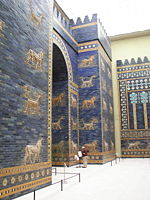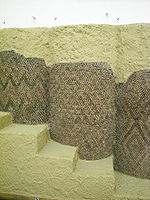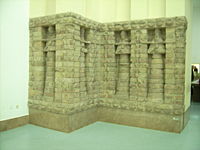
Vorderasiatisches Museum Berlin
Encyclopedia



Berlin
Berlin is the capital city of Germany and is one of the 16 states of Germany. With a population of 3.45 million people, Berlin is Germany's largest city. It is the second most populous city proper and the seventh most populous urban area in the European Union...
. It is in the basement of the south wing of the Pergamon museum
Pergamon Museum
The Pergamon Museum is situated on the Museum Island in Berlin. The site was designed by Alfred Messel and Ludwig Hoffmann and was constructed in twenty years, from 1910 to 1930. The Pergamon houses original-sized, reconstructed monumental buildings such as the Pergamon Altar and the Market Gate...
and has one of the world's largest collections of Southwest Asia
Southwest Asia
Western Asia, West Asia, Southwest Asia or Southwestern Asia are terms that describe the westernmost portion of Asia. The terms are partly coterminous with the Middle East, which describes a geographical position in relation to Western Europe rather than its location within Asia...
n art. 14 halls distributed across 2000 square meters of exhibition surface display southwest Asian culture spanning 6 millennia. The exhibits cover a period from the 6th millennium BCE into the time of the Muslim conquests. They originate particularly from today's states of Iraq
Iraq
Iraq ; officially the Republic of Iraq is a country in Western Asia spanning most of the northwestern end of the Zagros mountain range, the eastern part of the Syrian Desert and the northern part of the Arabian Desert....
, from Syria
Syria
Syria , officially the Syrian Arab Republic , is a country in Western Asia, bordering Lebanon and the Mediterranean Sea to the West, Turkey to the north, Iraq to the east, Jordan to the south, and Israel to the southwest....
and from Turkey
Turkey
Turkey , known officially as the Republic of Turkey , is a Eurasian country located in Western Asia and in East Thrace in Southeastern Europe...
, with singular finds also from other areas. Starting with the neolithic
Neolithic
The Neolithic Age, Era, or Period, or New Stone Age, was a period in the development of human technology, beginning about 9500 BC in some parts of the Middle East, and later in other parts of the world. It is traditionally considered as the last part of the Stone Age...
finds, the emphasis of the
collection is of finds from Sumer
Sumer
Sumer was a civilization and historical region in southern Mesopotamia, modern Iraq during the Chalcolithic and Early Bronze Age....
, Babylonia
Babylonia
Babylonia was an ancient cultural region in central-southern Mesopotamia , with Babylon as its capital. Babylonia emerged as a major power when Hammurabi Babylonia was an ancient cultural region in central-southern Mesopotamia (present-day Iraq), with Babylon as its capital. Babylonia emerged as...
, Assyria
Assyria
Assyria was a Semitic Akkadian kingdom, extant as a nation state from the mid–23rd century BC to 608 BC centred on the Upper Tigris river, in northern Mesopotamia , that came to rule regional empires a number of times through history. It was named for its original capital, the ancient city of Assur...
as well as the northern Syrian-east Anatolian area.
With excavations in historically important cities like Uruk
Uruk
Uruk was an ancient city of Sumer and later Babylonia, situated east of the present bed of the Euphrates river, on the ancient dry former channel of the Euphrates River, some 30 km east of modern As-Samawah, Al-Muthannā, Iraq.Uruk gave its name to the Uruk...
, Shuruppak
Shuruppak
Shuruppak or Shuruppag was an ancient Sumerian city situated about 35 miles south of Nippur on the banks of the Euphrates at the site of modern Tell Fara in Iraq's Al-Qādisiyyah Governorate....
, Assur
Assur
Assur , was one of the capitals of ancient Assyria. The remains of the city are situated on the western bank of river Tigris, north of the confluence with the tributary Little Zab river, in modern day Iraq, more precisely in the Al-Shirqat District .Assur is also...
, Hattusha, Tell el Amarna, Tell Halaf
Tell Halaf
Tell Halaf is an archaeological site in the Al Hasakah governorate of northeastern Syria, near the Turkish border, just opposite Ceylanpınar. It was the first find of a Neolithic culture, subsequently dubbed the Halaf culture, characterized by glazed pottery painted with geometric and animal designs...
(Guzana), Sam'al
Sam'al
Sam'al was a Hittite and Aramaean city located at Zincirli Höyük in the Anti-Taurus Mountains of modern Turkey's Gaziantep Province.-History:thumb|200px|right|Historical map of the Neo-Hittite states, ca...
, Toprakkale
Toprakkale
Rusahinili ", modern Toprakkale, Turkey) is an ancient Urartian fortress built by Rusa I, located near the modern city of Van in southeastern Turkey....
or Babylon
Babylon
Babylon was an Akkadian city-state of ancient Mesopotamia, the remains of which are found in present-day Al Hillah, Babil Province, Iraq, about 85 kilometers south of Baghdad...
came the ground of the museum collection. Further acquisitions come out of Nimrod
Nimrod
Nimrod means "Hunter"; was a Biblical Mesopotamian king mentioned in the Table of Nations; an eponym for the city of Nimrud.Nimrod can also refer to any of the following:*Nimród Antal, a director...
, Ninive, Susa
Susa
Susa was an ancient city of the Elamite, Persian and Parthian empires of Iran. It is located in the lower Zagros Mountains about east of the Tigris River, between the Karkheh and Dez Rivers....
or Persepolis
Persepolis
Perspolis was the ceremonial capital of the Achaemenid Empire . Persepolis is situated northeast of the modern city of Shiraz in the Fars Province of modern Iran. In contemporary Persian, the site is known as Takht-e Jamshid...
. The finds can among other things the advanced cultures of Sumer
Sumer
Sumer was a civilization and historical region in southern Mesopotamia, modern Iraq during the Chalcolithic and Early Bronze Age....
, Akkad
Akkad
The Akkadian Empire was an empire centered in the city of Akkad and its surrounding region in Mesopotamia....
, Babylonia
Babylonia
Babylonia was an ancient cultural region in central-southern Mesopotamia , with Babylon as its capital. Babylonia emerged as a major power when Hammurabi Babylonia was an ancient cultural region in central-southern Mesopotamia (present-day Iraq), with Babylon as its capital. Babylonia emerged as...
, Assyria
Assyria
Assyria was a Semitic Akkadian kingdom, extant as a nation state from the mid–23rd century BC to 608 BC centred on the Upper Tigris river, in northern Mesopotamia , that came to rule regional empires a number of times through history. It was named for its original capital, the ancient city of Assur...
, the Hittites
Hittites
The Hittites were a Bronze Age people of Anatolia.They established a kingdom centered at Hattusa in north-central Anatolia c. the 18th century BC. The Hittite empire reached its height c...
and the Aramaeans
Aramaeans
The Aramaeans, also Arameans , were a Northwest Semitic semi-nomadic and pastoralist people who originated in what is now modern Syria during the Late Bronze Age and the Iron Age...
. These finds often found their way to Berlin via the German Oriental Society (Deutsche Orient-Gesellschaft
Deutsche Orient-Gesellschaft
The Deutsche Orient-Gesellschaft is a Eingetragener Verein - a registered voluntary association - based at Berlin in Germany....
), and in 1899 the Middle East department at the royal museums was created. Then in 1929 the finds were provisionally accommodated in the Bode museum
Bode Museum
The Bode Museum is one of the group of museums on the Museum Island in Berlin, Germany; it is a historically preserved building. The museum was designed by architect Ernst von Ihne and completed in 1904...
, in the Pergamon museum, where they have been accessible to the public since 1930. During the Second World War
World War II
World War II, or the Second World War , was a global conflict lasting from 1939 to 1945, involving most of the world's nations—including all of the great powers—eventually forming two opposing military alliances: the Allies and the Axis...
there were hardly any war-related losses. The mobile exhibits, which was taken as art
Art theft
Art theft is usually for the purpose of resale or for ransom . Stolen art is sometimes used by criminals to secure loans.. One must realize that only a small percentage of stolen art is recovered. Estimates range from 5 to 10%. This means that little is known about the scope and characteristics of...
spoliage
Looting
Looting —also referred to as sacking, plundering, despoiling, despoliation, and pillaging—is the indiscriminate taking of goods by force as part of a military or political victory, or during a catastrophe, such as during war, natural disaster, or rioting...
to the Soviet Union, was returned to the GDR in 1958. Already in 1953 the collection was opened again as Vorderasiatisches Museum. Pieces of splendor of the collection are the Ishtar Gate
Ishtar Gate
The Ishtar Gate was the eighth gate to the inner city of Babylon. It was constructed in about 575 BC by order of King Nebuchadnezzar II on the north side of the city....
and Procession way of Babylon, remainders of the tower of Babel
Tower of Babel
The Tower of Babel , according to the Book of Genesis, was an enormous tower built in the plain of Shinar .According to the biblical account, a united humanity of the generations following the Great Flood, speaking a single language and migrating from the east, came to the land of Shinar, where...
, parts of the Eanna temple and the Inanna
Inanna
Inanna, also spelled Inana is the Sumerian goddess of sexual love, fertility, and warfare....
temple Kara Indash
Karaindash
Karaindaš was one of the more prominent rulers of the Kassite dynasty and reigned towards the end of the 15th century, BC. An inscription on a tablet detailing building work calls him “Mighty King, King of Babylonia, King of Sumer and Akkad, King of the Kassites, King of Karuduniaš”.Tablet A 3519,...
from Uruk. Besides the
museum accommodates an important number of Southwest Asian stamp
Stamp seal
The stamp seal is a carved object, usually stone, first made in the 4th millennium BC, and probably earlier. They were used to impress their picture or inscription into soft, prepared clay....
- and cylinder seal
Cylinder seal
A cylinder seal is a cylinder engraved with a 'picture story', used in ancient times to roll an impression onto a two-dimensional surface, generally wet clay. Cylinder seals were invented around 3500 BC in the Near East, at the contemporary site of Susa in south-western Iran and at the early site...
s as well as cuneiform
Cuneiform
Cuneiform can refer to:*Cuneiform script, an ancient writing system originating in Mesopotamia in the 4th millennium BC*Cuneiform , three bones in the human foot*Cuneiform Records, a music record label...
texts. At present Beate Salje is the director of the museum. Previous directors were among others Walter Andrae, Gerhard Rudolf Meyer, Liane Jakob Rust and Evelyn Klengel Brandt.
Literature
- Nicola Crüsemann (ed.): Vorderasiatisches Museum Berlin. Geschichte und Geschichten zum hundertjährigen Bestehen, national museums of Berlin, Stiftung Preußischer Kulturbesitz, Berlin 2000
- Nicola Crüsemann: Vom Zweistromland zum Kupfergraben. Vorgeschichte und Entstehungsjahre (1899 -1918) der Vorderasiatischen Abteilung der Berliner Museen vor fach- und kulturpolitischen Hintergründen, Berlin 2001 (Jahrbuch der Berliner Museen N. F. 42 (2000), Beiheft)
- Liane Jakob rust et al., Das Vorderasiatische Museum, of Zabern, Mainz 1992.
- Joachim Marzahn, Beate Salje (eds.): Wiedererstehendes Assur: 100 Jahre deutsche Ausgrabungen in Assyrien, of Zabern, Mainz 2003.
- Beate Salje: Vorderasiatische Museen: gestern, heute, morgen. Berlin, Paris, London, New York; eine Standortbestimmung; Kolloquium aus Anlass des Einhundertjährigen Bestehens des Vorderasiatischen Museums Berlin am 7. Mai 1999, of Zabern, Mainz 2001.

